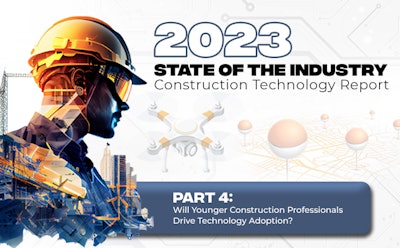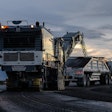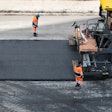
Part 4:
In this IRONPROS research report, we examine the degree to which younger professionals entering the construction industry will drive adoption of transformational technologies including:
- Artificial Intelligence (AI)
- Internet of Things (IoT)
- Augmented/Virtual Reality
- Connected Equipment
- Autonomous Equipment
This article is part four of the FULL 2023 State of the Industry: Construction Technology Report, a four-part series that outlines the growing technology present in the construction industry, how contractors are currently embedding the technology into their workflow, the future of disruptive technology and the impact technology will have in acquiring a younger generation. Use the navigation bar below to maneuver through valuable industry insight:
- PART 1: IRONPROS Research Finds Field Productivity Software Most Significant Construction Technology Going into 2023
- PART 2: GPS-Asset Tracking Hardware, a Top 2023 Equipment Technology Priority
- PART 3: IRONPROS Study Reveals the Future of Disruptive Technology in Construction
- CURRENT ARTICLE - PART 4: Will Younger Construction Professionals Drive Technology Adoption?
- DOWNLOAD THE PDF *Save to your desktop for easy reading & reference
- FULL 2023 State of the Industry: Construction Technology Report
Multiple construction experts, journalists and vendors have posited that while the construction industry has been slow to adopt these technologies when compared to other industrial sectors, technology could be helpful in attracting younger workers.
Some have also posited that more complete adoption of these technologies across various industries may be helped along by these same younger workers. One 2019 report from the Committee for European Construction Equipment describes this “chicken and egg” problem where younger people are more accepting of technology, but technology will be helpful for recruiting younger workers:
“From the interviews it emerges that the construction sector suffers from a ‘generational issue.’ Older workers, who have developed a strong expertise and knowledge, represent the majority of the construction workforce (in the US the average age of construction workers has increased by seven years between 1985 and 2014 and the trend is similar in EU countries as stated in the European Construction Sector Observatory reports). However, they tend to be less open to the adoption of digital technologies. While the average age of construction workers has been constantly increasing and in many cases retirement age is approaching, it is not been coupled with an increased presence of younger generations. Young people still consider the construction sector as ‘dirty, dangerous and demeaning.’ This is also one of the reasons why the number of women in the sector tends to be much lower than their male counterparts.”
During 2022, IRONPROS surveyed almost 200 construction professionals on their current usage of or plans to use various equipment and field technologies, as well as their opinions of how important transformational technologies will be in coming years.
Respondents Were Asked:
- Which of the following transformational technologies are already embedded in your equipment or software and which do you see as becoming important in the future?
Respondents Answered:
- Artificial intelligence technologies that help make decisions:
- Sensors that relay data for decision support, analysis or to trigger actions
- Augmented or virtual reality for safety training or project visualization
- Real-time information sharing between all machines on the job site
For each transformational technology, IRONPROS asked if respondents were using that technology now, whether it would be important in the next five years, in the next 10 years or would not be important at all. By cross-tabulating a demographic question on respondent's age with this question, IRONPROS was able to determine to what extent younger people see potential in these transformational technologies when compared to older professionals.
Takeaways from this Exercise Include:
- The number of respondents in the youngest age group of 18-25 was a tiny minority, which suggests that among the AC Business Media construction audience, they are under-represented in this sector.
- While the number of 18-25-year-olds was small, those in the study were less likely to see the potential of these technologies than respondents at the older end of the age range.
- While 100 percent of the 18-25-year-old segment said their company was already using or saw potential for interconnected equipment, this represents a handful of individuals out of the study and may be the topic for further research with a larger sample of younger construction professionals.
- While digital natives may be fluent users of consumer technologies, understanding how technology may be applied to business problems is the purview of more senior professionals, managers and executives who tend to be older.
- The age demographic most likely to see potential; in each of these transformational technologies, apart from the 100 percent score for connected equipment among 18-25-year-olds, were respondents age 46-55.
- Among respondents indicating they worked in corporate management; 87 percent were older than 46. These are the individuals charged with taking construction businesses into the 21st Century, and while many would not be considered “digital natives,” they will have the business acumen to align processes and technologies and will be the ones held accountable for the success or failure.
Related Content
- Owners Push Contractors Towards Digital Intercompany Workflows
- 2023 New Years Resolutions for the Construction Industry
- Changing the Conversation Around Construction Careers to Lure Labor
- 4 Factors Delaying Digital Transformation in Construction
- Aging Workers Drive Construction Labor Gap
----
FULL CONSTRUCTION TECHNOLOGY STUDY:
Navigate to your next insightful report:
- PART 1: IRONPROS Research Finds Field Productivity Software Most Significant Construction Technology Going into 2023
- PART 2: GPS-Asset Tracking Hardware, a Top 2023 Equipment Technology Priority
- PART 3: IRONPROS Study Reveals the Future of Disruptive Technology in Construction
- CURRENT ARTICLE - PART 4: Will Younger Construction Professionals Drive Technology Adoption?
- DOWNLOAD THE PDF *Save to your desktop for easy reading & reference
- FULL 2023 State of the Industry: Construction Technology Report















